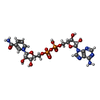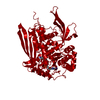+Search query
-Structure paper
| Title | Disorder-to-order active site capping regulates the rate-limiting step of the inositol pathway. |
|---|---|
| Journal, issue, pages | Proc Natl Acad Sci U S A, Vol. 121, Issue 34, Page e2400912121, Year 2024 |
| Publish date | Aug 20, 2024 |
 Authors Authors | Toni K Träger / Fotis L Kyrilis / Farzad Hamdi / Christian Tüting / Marie Alfes / Tommy Hofmann / Carla Schmidt / Panagiotis L Kastritis /   |
| PubMed Abstract | Myo-inositol-1-phosphate synthase (MIPS) catalyzes the NAD-dependent isomerization of glucose-6-phosphate (G6P) into inositol-1-phosphate (IMP), controlling the rate-limiting step of the inositol ...Myo-inositol-1-phosphate synthase (MIPS) catalyzes the NAD-dependent isomerization of glucose-6-phosphate (G6P) into inositol-1-phosphate (IMP), controlling the rate-limiting step of the inositol pathway. Previous structural studies focused on the detailed molecular mechanism, neglecting large-scale conformational changes that drive the function of this 240 kDa homotetrameric complex. In this study, we identified the active, endogenous MIPS in cell extracts from the thermophilic fungus . By resolving the native structure at 2.48 Å (FSC = 0.143), we revealed a fully populated active site. Utilizing 3D variability analysis, we uncovered conformational states of MIPS, enabling us to directly visualize an order-to-disorder transition at its catalytic center. An acyclic intermediate of G6P occupied the active site in two out of the three conformational states, indicating a catalytic mechanism where electrostatic stabilization of high-energy intermediates plays a crucial role. Examination of all isomerases with known structures revealed similar fluctuations in secondary structure within their active sites. Based on these findings, we established a conformational selection model that governs substrate binding and eventually inositol availability. In particular, the ground state of MIPS demonstrates structural configurations regardless of substrate binding, a pattern observed across various isomerases. These findings contribute to the understanding of MIPS structure-based function, serving as a template for future studies targeting regulation and potential therapeutic applications. |
 External links External links |  Proc Natl Acad Sci U S A / Proc Natl Acad Sci U S A /  PubMed:39145930 / PubMed:39145930 /  PubMed Central PubMed Central |
| Methods | EM (single particle) |
| Resolution | 2.48 Å |
| Structure data | EMDB-50149, PDB-9f2k: |
| Chemicals |  ChemComp-NAD: |
| Source |
|
 Keywords Keywords | ISOMERASE / inositol metabolism / endogenous / conformational selection |
 Movie
Movie Controller
Controller Structure viewers
Structure viewers About Yorodumi Papers
About Yorodumi Papers





 thermochaetoides thermophila dsm 1495 (fungus)
thermochaetoides thermophila dsm 1495 (fungus)